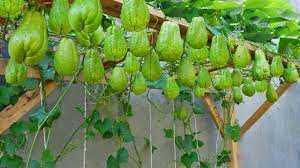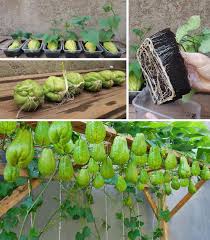If you’re a gardening enthusiast with limited space, growing your own fresh produce is more achievable than ever. Chayote (Sechium edule), a unique vegetable from Central America, is perfect for container gardening. With its mild, crisp texture and versatile culinary uses, chayote is an ideal choice for urban gardeners or anyone looking to maximize small garden spaces.
Why Grow Chayote?
Chayote, also known as vegetable pear or mirliton, belongs to the gourd family and is recognized for its delicate flavor, often described as a cross between cucumber and zucchini. Its pear-shaped fruits, typically pale green, offer a refreshing crunch and can be used in a variety of dishes, from salads to soups.
Container Gardening Tips for Chayote
1. Choose the Right Container
Chayote plants have extensive root systems and long vines, so it’s crucial to pick a container that’s at least 5 gallons in size with excellent drainage. A deep container will ensure the plant’s roots and vines have room to grow.
2. Select an Optimal Location
Chayote thrives in full sunlight, so place your container in a sunny spot. If you have limited space, consider using vertical gardening techniques. A trellis or stakes will allow the vines to grow upwards, saving ground space and encouraging better air circulation.
3. Planting Your Chayote
Before planting, install a trellis or support structure in the container to guide the vines as they grow. Plant a single chayote fruit, or “fruit-set,” about 2-3 inches deep into well-draining soil. Water it generously after planting to help it establish roots.

4. Care and Maintenance
Chayote plants need regular watering to keep the soil consistently moist—avoid waterlogging. Apply a balanced, all-purpose fertilizer every 4-6 weeks to support healthy growth. As the plant matures, gently guide the vines up the trellis to prevent tangling and ensure the plant remains tidy.
5. Pruning for Healthy Growth
Prune your chayote regularly by removing dead or yellowing leaves. Cutting back excess growth will help the plant receive more sunlight and encourage fruit production. This also ensures the vines don’t become overcrowded and stressed.
Harvesting and Enjoying Your Chayote
Chayote fruits are ready to harvest when they reach a size of about 4-6 inches. Use a sharp knife to carefully cut the fruits from the vine, leaving a small stem attached. Fresh chayote is delicious in a variety of dishes. It can be eaten raw in salads, sautéed in stir-fries, or used in soups and casseroles. Chayote can even be pickled for a tangy treat.
The Joy of Homegrown Chayote
Growing chayote in containers is an accessible and rewarding gardening project, even for those with limited space. With a little care and attention, you can enjoy a thriving chayote plant on your balcony, patio, or windowsill. The bountiful harvest you reap will provide fresh, flavorful vegetables to enhance your meals and make your gardening efforts truly satisfying. So why not start today? Embrace the joys of homegrown chayote and savor the taste of success!
